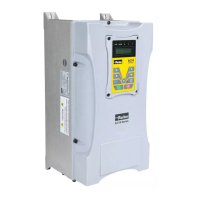What if I entered the wrong password on my Parker Controller?
- GgbanksSep 23, 2025
If you entered the wrong password on your Parker Controller when the password function is valid, set the password correctly.

What if I entered the wrong password on my Parker Controller?
If you entered the wrong password on your Parker Controller when the password function is valid, set the password correctly.
What to do if my Parker Controller displays 'Inverter Overload'?
If your Parker Controller is showing an inverter overload, it could be due to a load that is too heavy. Try to reduce the load, check the drive ratio, or increase the inverter’s capacity.
What causes a Parker Controller to display 'Motor Overload'?
A 'Motor Overload' message on your Parker Controller typically indicates that the load is too heavy. You should reduce the load, check the drive ratio, or increase the motor’s capacity.
What should I do if my Parker AC10 Controller shows DC Over-Voltage?
If your Parker Controller displays a DC Over-Voltage error, consider the following potential causes and solutions: 1. Supply voltage too high: Check if the rated voltage is input. 2. Load inertia too big: Add braking resistance (optional). 3. Deceleration time too short: Increase deceleration time. 4. Motor inertia rise again: Set the parameter of rotary speed loop PID correctly. 5. Parameter of speed loop PID is set abnormally: Set the parameter of rotary speed loop PID correctly.
What to do if Parker AC10 Controller shows Current Zero Excursion Malfunction?
If your Parker Controller shows a 'Current Zero Excursion Malfunction', check the flat cable. If the issue persists, contact Parker.
How to fix communication timeout on Parker AC10 Controller?
To fix a communication timeout on your Parker Controller, check whether the communication line is connected reliably.
What causes the wrong direction of motor running on a Parker AC10?
If the motor is running in the wrong direction with your Parker Controller, check if the U, V, W wiring is correct and ensure the parameters are set correctly.
What does 'Line Disconnected' mean on my Parker Controller?
If your Parker Controller displays 'Line Disconnected', it indicates that the analog signal line is disconnected or the signal source is broken. Try changing the signal line or the signal source.
What causes a Parker AC10 Controller to have output phase loss?
An output phase loss in your Parker Controller could be due to a broken motor, loose motor wires, or a broken inverter. Check if the motor is broken, if the motor wires are loose, and if the inverter is broken.
What to do if my Parker Controller trips the power?
If your Parker Controller is tripping the power, it might be because the wiring current is too high. Check the input wiring, select a matching air switch, reduce the load, and check for any inverter malfunctions.
| Overload Capacity | 150% for 60 seconds |
|---|---|
| Analog Inputs | 2 |
| Analog Outputs | 1 |
| Communication Options | Modbus RTU |
| Protection Rating | IP20 |
| Input Voltage | 200-240VAC, 380-480VAC, 500-575VAC, 600VAC, 690VAC |
| Digital Outputs | 2 |
| Protection | Overcurrent, Overvoltage, Undervoltage, Overtemperature, Short Circuit |
| Operating Temperature | -10°C to +50°C |
| Humidity | 5% to 95% (non-condensing) |
| Dimensions | Varies by model |
| Weight | Varies by model |
| Braking | Built-in dynamic braking |
Important precautions to take before and during equipment installation.
Explains how to set and modify inverter parameters using the keypad.
Guidelines for vertical installation and required clearance dimensions.
Instructions for connecting power supply, motor, and grounding terminals.
Detailed description of each control terminal and its function.
Techniques for reducing electromagnetic interference (EMI) and noise.
Explains how to use the keypad for parameter setting, monitoring, and control.
Covers fundamental parameters like password, rated current, power, and control mode.
Parameters related to start/stop commands, direction setting, and frequency sources.
Configuration of digital and analog I/O terminals for various functions.
Parameters for configuring analog input channels and output signals.
Parameters for overload protection, fault detection, and system protection.
Crucial parameters for motor identification, tuning, and performance optimization.
Settings for Modbus communication, including address, mode, and baud rate.
Parameters for configuring the Proportional-Integral-Derivative control loop.
Lists common fault codes, their causes, and possible solutions for the inverter.
Provides guidance on diagnosing and resolving motor-related malfunctions.
Information on electromagnetic compatibility and potential radio interference.
Parameters related to start/stop commands, direction setting, and frequency sources.
Configuration of digital and analog I/O terminals for various functions.
Parameters for timing control and system protection features.
Crucial parameters for motor identification, tuning, and performance optimization.
